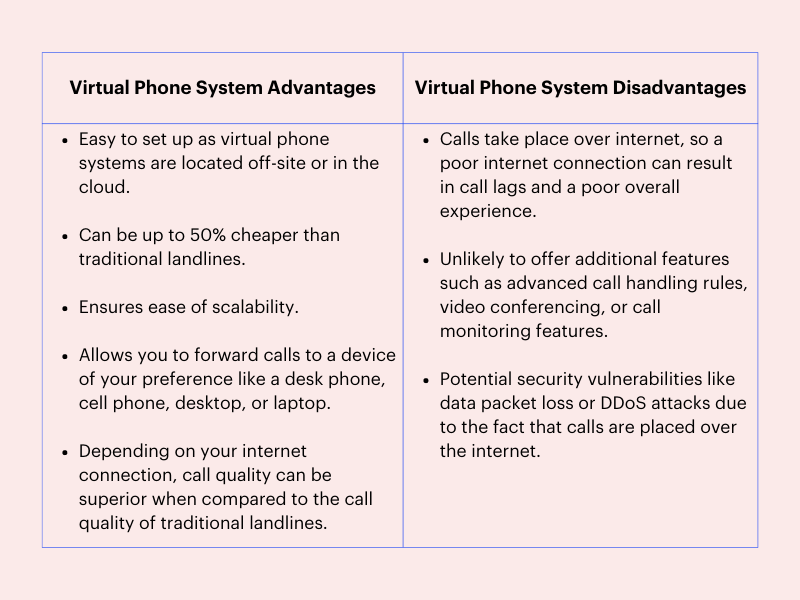What is a Virtual Phone?
If your business has a traditional landline system in place, you’re probably spending a pretty penny on maintenance, making international calls, equipment, and more.
Or maybe you’ve switched to a VoIP platform but don’t want—or need—to tap into its wide range of advanced features like video conferencing and team chat.
In either case, a virtual phone system might be the right fit for you.
What’s a virtual phone system? And how can it help you reduce your telecommunications costs? In this blog post, we’ll help you dive deep into the world of virtual phone systems.
What is a Virtual Phone System?
A virtual phone system is a cloud-based phone system that can handle incoming and outgoing business phone calls, voicemail messages, text messages, and more. It’s powered by VoIP but offers fewer features.
A virtual phone system is a perfect, cost-effective fit for startups that don’t want to invest in advanced VoIP platform features.
Setting up a virtual phone system is less complicated when compared with traditional landline systems as you don’t need to deal with gazillions of twisted copper wires, resulting in lesser maintenance.
Virtual phone systems come with a variety of features depending on who your provider is. Some features might include:
- Name directory
- Fax on demand
- Call forwarding
- Music on hold
- Call screening
- Local and toll-free numbers
- The ability to read your voicemails
Whereas VoIP platforms may come with additional features such as:
- Multi-level auto-attendant
- Advanced call handling rules
- Video conferencing
- Analytics using artificial intelligence
- Call monitoring features
These sets of features may vary, depending on the virtual phone number provider you choose.
Now that you have a better understanding of what a virtual phone system is, let’s get into how a virtual phone system works.
How Does a Virtual Phone System Work?
How a virtual phone system works is kind of technical, but here is a basic rundown.
Virtual phone systems are located off-site or in the cloud and are usually hosted by a third party, so businesses don’t have to waste their time or money on setting everything up. When you receive a call, it’s routed to any device of your preference like a desk phone, cell phone, desktop, laptop, etc.
When a call is made over this virtual network, an endpoint between the callee and the caller is established. The voice data is broken up into “packets.” These packets travel over the internet, and when they reach the intended recipient, they change back into voice data.
One benefit to point out is that outgoing calls can be managed much better as a result of adjustable dialing speeds and integration with CRM systems.
Another plus? A virtual phone system makes it so that you don’t need to stick to your desk to take calls anymore. You can take care of customers from your favorite coffee shop, home office, or other location of your choice—that’s the power of technology.
The Advantages & Disadvantages of a Virtual Phone System
Next, let’s look at the advantages and disadvantages of a virtual phone system.
A virtual phone system offers numerous benefits over a traditional landline system. From cost savings to ease of accessibility to the ability to forward incoming calls to a mobile phone, desktop, or device(s) of your choice, it’s a no-brainer for many businesses to switch to a virtual phone system. However, it’s important to note that since calls on a virtual phone system take place over the internet, if your business is headquartered in a remote location with poor internet access, a traditional landline system still might be the superior option.
When compared with a VoIP platform, virtual phone systems are less expensive, as you won’t be paying for advanced features like advanced call handling rules, or video conferencing. It’s a perfect fit for small-sized or medium-sized businesses that don’t require these advanced features.
Here is a table that outlines more pros and cons.

VoIP Platforms vs. Virtual Phone Systems—What’s the Difference?
Lastly, let’s get clear on the differences between VoIP platforms and Virtual Phone Systems.
First, it’s important to note that a VoIP platform is a great option for team collaboration, thanks to advanced features like virtual work and meeting spaces, messaging channels similar to Slack or Microsoft Teams, task management, and more. Whereas virtual phones are limited to text and voice.
Next, many VoIP platforms offer advanced call handling and management options like multi-level auto-attendants, dial-by-name directory, call queues, and call screening and blocking. On the other hand, virtual phone systems offer fewer options and are limited to call forwarding, ring groups, and a few more.
VoIP platforms hold a bit of an upper hand over virtual phone systems, but you’ll pay a price for it. If you run a startup or small business and don’t want to tap into these exclusive VoIP features, implementing a VoIP platform doesn’t make sense; you’ll just be wasting your money. If you’re willing to forgo advanced features in favor of a lower price tag, a virtual phone system is a good option.
Deciding What’s Right for Your Business
If you’re still using a traditional landline, making the switch to a more modern solution is a no-brainer. If you’re debating between a virtual phone or a VoIP platform, the answer is less clear-cut—it depends on your specific needs. If you’re on the hunt for a modern, cost-effective phone solution, a virtual phone system might be right for you.
















